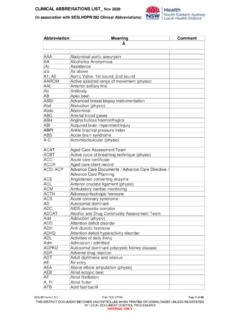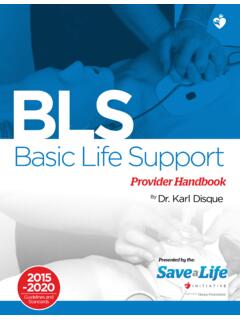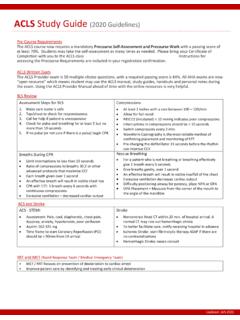Transcription of ANZCOR Guideline 11.2 – Protocols for Adult Advanced Life ...
1 ANZCOR Guideline August 2018 Page 1 of 8 ANZCOR Guideline Protocols for Adult Advanced life Support Summary Who does this Guideline apply to? This Guideline applies to adults who require Advanced life support (ALS). Who is the audience for this Guideline ? This Guideline is for health professionals and those who provide healthcare in environments where equipment and drugs are available. Recommendations The Australian and New Zealand Committee on Resuscitation ( ANZCOR ) make the following recommendations: 1. That the Adult ALS algorithm be used as a tool to manage all adults who require Advanced life support. 2. Good quality CPR and reducing time to defibrillation are the highest priorities in resuscitation from sudden cardiac arrest .
2 3. Rescuers should aim to minimise interruptions to CPR during any ALS intervention. ANZCOR Guideline August 2018 Page 2 of 8 Guideline 1 Advanced life Support algorithm The flow diagram illustrates the sequence of actions to be undertaken once equipment and drugs are available. Several tasks in the diagram may be undertaken at the same time. The algorithm is based on the following considerations: 1. The importance of good CPR and early defibrillation in achieving successful outcomes. Ventricular Fibrillation (VF) is in many situations the primary rhythm in sudden cardiac arrest . The vast majority of survivors come from this group. The chance of successful defibrillation decreases with time. Therefore the performance of good CPR and decreasing the time to defibrillation are the highest priorities in resuscitation from sudden cardiac arrest .
3 The amplitude and waveform of VF deteriorate as high energy phosphate stores in the myocardium decrease. This rate of decrease can be slowed, or even reversed by effective 2. Automated External Defibrillators (AEDs) can accurately diagnose cardiac rhythms and separate them into two groups: a. Shockable = those responsive to defibrillation b. Non-shockable = those unresponsive to defibrillation 3. There are interventions that are indicated in all causes of cardiac arrest . 4. There is a group of potentially reversible conditions that, if unrecognised or left untreated during cardiac arrest , may prevent successful resuscitation. 2 Notes on the algorithm Good quality CPR The provision of good quality CPR is the cornerstone of Advanced life support.
4 As outlined in Guideline this includes delivery of chest compressions over the lower half of the sternum at a depth of at least 5 cm, and at a rate of approximately 100-120 per minute, while minimising interruptions to compressions at all times. Assess rhythm As soon as the defibrillator is available, the pads should be placed on the patient s chest, it should be charged and, the rhythm analyzed. If a rhythm compatible with spontaneous circulation is observed, the defibrillator should be disarmed and the pulse checked [Class A; Expert Consensus Opinion]. ANZCOR Guideline August 2018 Page 3 of 8 Shockable Rhythm Ventricular fibrillation is asynchronous chaotic ventricular activity that produces no cardiac output.
5 Pulseless ventricular tachycardia is a wide complex regular tachycardia associated with no clinically detectable cardiac output. A defibrillator shock should be administered according to the algorithm . Administer a single shock and immediately resume CPR for 2 minutes after delivery of shock. Do not delay recommencing CPR to assess the rhythm. [Class A; LOE II to IV]2 Energy levels Monophasic: the energy level for adults should be set at maximum (usually 360 Joules) for all shocks. [Class A; LOE II]2 Biphasic waveforms: the default initial energy level for adults should be set at 200J. Other energy levels may be used providing there is relevant clinical data for a specific defibrillator that suggests that an alternative energy level provides adequate shock success (eg.)
6 Usually greater than 90%) [Class A; LOE II]2 . ANZCOR suggests that if the first shock is not successful and the defibrillator is capable of delivering shocks of higher energy, it is reasonable to increase the energy to the maximum available for subsequent shocks (CoSTR 2015 weak recommendation, very low quality evidence).3 Immediate CPR Interruptions to CPR decrease the chance of survival from cardiac arrest . While defibrillation is of paramount importance for VF/VT, a period of well performed CPR immediately after each shock can help maintain myocardial and cerebral viability, and improves the likelihood of subsequent shock During CPR Advanced life support interventions are applied and potential causes of arrest sought.
7 After each defibrillation continue a further 2 minutes of CPR, unless responsiveness or normal breathing become apparent. If using a defibrillator in manual mode, the defibrillator should be charged during CPR as the end of the 2 minute loop of CPR approaches, to minimise interruptions to CPR and increase the likelihood of shock Rhythm is then reassessed and treatment is directed as necessary. If rhythm assessment results in a significant interruption to CPR then a further 2-minute period of CPR is recommended before further shocks are delivered. This is done to obtain the benefits of CPR on VF waveform and increase the likelihood of shock success. Consideration should be given to administration of a vasopressor in the period of CPR after the second failed defibrillation attempt.
8 Consideration should be given to administration of an antiarrhythmic after the third failed defibrillation attempt. The sequence of escalating Advanced life support would then be: 1. attempt defibrillation ensure good CPR 2. attempt defibrillation add vasopressor (adrenaline 1 mg) 3. attempt defibrillation, add anti-arrhythmic (amiodarone 300 mg). [Class A; LOE II to IV]2 ANZCOR Guideline August 2018 Page 4 of 8 Non-shockable rhythm (Non VF/VT) Asystole is characterised by the absence of any cardiac electrical activity. Pulseless Electrical Activity (PEA) (sometimes referred to Electromechanical Dissociation [EMD]) is the presence of a coordinated electrical rhythm without a detectable cardiac output.
9 The prognosis in this group of cardiac rhythms or asystole is much less favourable than with VF/VT. During CPR Advanced life support interventions are applied and potential causes of arrest sought. Defibrillation is not indicated and the emphasis is on CPR and other ALS interventions ( intravenous access, consideration of Advanced airway, drugs and pacing). [Class A; Expert consensus opinion]. During CPR The following interventions apply to all rhythms and are carried out continuously or during each loop of the algorithm . Each loop comprises 5 sets of 30 compressions (at approximately 100-120 per minute) : 2 breaths, which equates to approximately 2 minutes. Other management priorities during CPR: Minimise interruptions to CPR during ALS interventions [Class A; LOE III-2].
10 Administer 100% oxygen when available (CoSTR 2015 weak recommendation, very low quality evidence).3 Obtain intravenous or intra-osseous access [Class A; LOE II]. Consider airway adjuncts, but attempts to secure the airway should not interrupt CPR for more than 5 seconds [Class A; Expert consensus opinion]. Waveform capnography should be used to confirm airway placement and monitor the adequacy of CPR (CoSTR 2015 strong recommendation, low quality evidence).3 Adrenaline should be administered every second loop (approximately every 4 minutes) [Class A; Expert consensus opinion]. Other drugs/electrolytes should be considered depending on the individual circumstances [Class A; Expert consensus opinion]. Medications during CPR Vasopressors There are no placebo-controlled studies that show that the routine use of any vasopressor at any stage during human cardiac arrest increases survival to hospital discharge, though they have been demonstrated to increase Return of Spontaneous Circulation.












